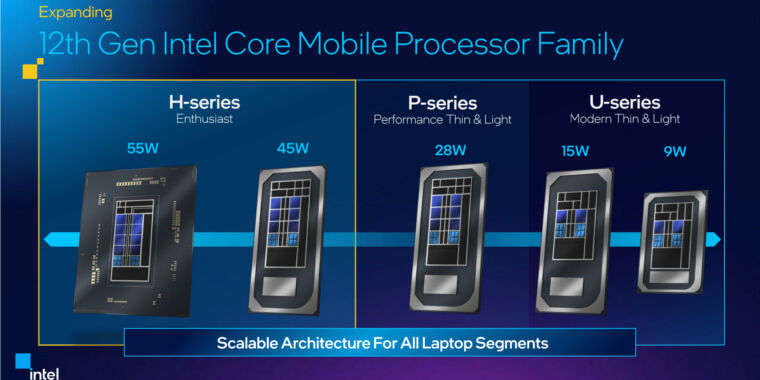
Intel
Earlier this year, Intel announced three iterations of its 12th-generation Alder Lake CPU architecture for laptops: the U-series, which includes thin and light Ultrabooks, the P-series for thin and light workstation laptops, and the H-series for sturdier workstations. and gaming laptops with more room for large processor fans and heatsinks.
Now Intel is adding another series of chips: the HX series, designed for even faster laptops. Despite sharing a letter with the H-series chips, the H and HX CPUs don’t have much in common. The H-series chips are scaled-up versions of Intel’s laptop processors with more powerful integrated GPUs, integrated Thunderbolt, and a built-in chipset controller on the same package as the rest of the CPU. The HX chips, on the other hand, use the same dies as Intel’s desktop Alder Lake chips, but are soldered to a laptop’s motherboard instead of being plugged into a CPU socket.
| Processor | P and E cores | P-core clocks (Boost) | Basic TDP | Turbo TDP |
|---|---|---|---|---|
| Core i5-12450HX | 4P/4E | 2.4GHz (4.4GHz) | 55W | 157W |
| Core i5-12600HX (vPro) | 4P/8E | 2.5GHz (4.6GHz) | 55W | 157W |
| Core i7-12650HX | 6P/8E | 2.0GHz (4.7GHz) | 55W | 157W |
| Core i7-12800HX | 8P/8E | 2.0GHz (4.8GHz) | 55W | 157W |
| Core i7-12850HX (vPro) | 8P/8E | 2.1GHz (4.8GHz) | 55W | 157W |
| Core i9-12900HX | 8P/8E | 2.3GHz (5.0GHz) | 55W | 157W |
| Core i9-12950HX (vPro) | 8P/8E | 2.3GHz (5.0GHz) | 55W | 157W |
These CPUs have higher TDPs than their H-series counterparts, with 55 W base TDPs instead of 45 W and 157 W Turbo TDPs instead of the 95-to-115 W TDPs of the H-series. Due to the power increase, these chips will run faster for longer than H-series processors, at the cost of higher power consumption and higher heat dissipation. However, our tests of these desktop chips suggest that the Core i7 and i9 processors will benefit more from the increased power limits than the Core i5 versions with lower core counts.
Being a scaled down and repackaged desktop chip, it offers some advantages and disadvantages compared to regular H-series laptop processors. On a positive note, the Core i7 and Core i9 chips offer an additional pair of P-cores and eight efficiency cores, for 16 cores and 24 threads. As long as your laptop can handle the extra power requirements, they should be useful for CPU-heavy productivity and rendering tasks.
These processors also support PCI Express 5.0, although it doesn’t make much sense just yet – current GPUs and SSDs don’t use the new standard yet, and they won’t for a while. They also support memory overclocking just like their desktop counterparts, and the vPro compatible versions also support ECC memory.

Intel
Whether you suffer from the drawbacks depends on what you are doing. The chips’ integrated GPUs come in at 32 execution units (EUs), versus a maximum of 96 in the H-series CPUs. Laptops with HX processors almost certainly include dedicated GPUs, which usually won’t be a problem, but the CPUs’ lack of integrated Thunderbolt 4 connectivity is more noticeable. Up to two dedicated Thunderbolt controllers can be added, but that adds cost and complexity.
The Core i7 and i9 HX series chips may make sense for people who need all the CPU performance they can get in a laptop, but the odd Core i5 HX offering is probably best avoided. They only contain four P-cores and four or eight E-cores, no more than the regular H-series chips, and at these core numbers, they’re unlikely to benefit much from their increased TDPs.
Intel didn’t give a specific availability date for laptops with HX-series CPUs, but said “more than 10 workstation and gaming designs” would come from the PC companies this year.
List image by Intel

